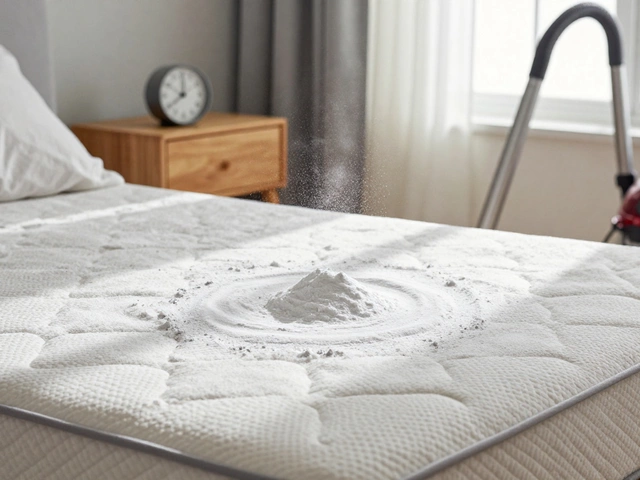Moving out of a rental in California and worried about the surprise charges? One thing that often pops up is whether a landlord can ding you for painting. Different situations can alter the answer, so let's break it down.
First, we need to chat about what's called 'normal wear and tear.' Over time, it's natural for walls to show some signs of life. A few scuffs from furniture or sun-fading might fall under this category, and landlords shouldn't charge you for fresh paint just because the place has been lived in.
But hold on—if your beautiful artwork or that epic poster wall has left some damage, that's a different story. In California, if the paint job exceeds normal wear, it might be reasonable for the landlord to expect some compensation for repainting. It's about knowing when your responsibilities kick in over the landlord's basic upkeep duties.
- Understanding Normal Wear and Tear
- Landlord Responsibilities
- Tenant Responsibilities
- What Happens in California
- Dispute Resolution
- Practical Tips for Tenants
Understanding Normal Wear and Tear
When you're renting in California, normal wear and tear is kind of like the wrinkles in your favorite t-shirt—expected and totally normal. So, what does it really mean in the context of renting a place? Let's unpack it.
Simplistically put, normal wear and tear involves changes that happen simply by living in a space for a while. This includes minor marks on walls, loose door handles, or even worn carpets; things that don’t indicate any negligence or mishandling.
Examples of Normal Wear and Tear
- Faded wall paint due to sunlight exposure.
- Slight scratches on the floor from everyday use.
- Loose bathroom tiles from prolonged usage.
- Worn out, discolored carpet areas primarily in traffic zones.
With these, landlords can't really blame tenants or charge them, especially when it's a consequence of reasonable usage.
What Doesn’t Fall Under Normal Wear and Tear?
Now, some things go beyond just living—they're the result of accidents or plant-a-flag-in-the-ground unknowns like spilling paint or knocking a hole in the wall from that missed dartboard target.
- Holes in walls from nails or mounting brackets for televisions and shelves.
- Larger stains or rips in the carpet caused by pets or spills.
- Broken windows due to negligence or carelessness.
In these cases, landlord charges can be justified.
Recognizing what counts as regular wear can equip you with better conversation points if your landlord tries to charge you for repainting unnecessarily.
Landlord Responsibilities
When it comes to maintaining a rental property in California, landlords have their set of duties. Understanding these can save you from unnecessary bills. Generally, a landlord is responsible for keeping the place habitable. That means taking care of structural repairs, plumbing, and ensuring the place complies with health and safety standards.
Now, let's talk about the condition of paint. According to California's Civil Code, landlords must ensure the rental unit is in good order when handing it over to a new tenant. Over time, a reasonable amount of maintenance, including paint touch-ups, comes with the territory. But, believe it or not, your landlord can’t charge you for routine upkeep once you leave.
When Landlords Can Charge
Here's where it gets interesting. If, for example, you’ve lived in the unit for over a year and left the walls covered in noticeable marks or damage, then the landlord might be in the right to charge you for a fresh coat. On the flip side, regular fading or a few nail holes shouldn’t be enough to justify costs.
Paint Obligation Cycles
There are no hard and fast rules, but a good landlord might repaint every three to five years, depending on how the property is maintained. This cycle considers normal wear and tear and isn't something you should pay for as you bid farewell to the apartment.
So, while landlords have obligations to keep the premises neat and safe, distinguishing between routine duties and tenant-caused issues is key. Clarity on this will help you know what charges are fair and which are not.
Tenant Responsibilities
As a tenant, it's key to understand what you're responsible for regarding the condition of your rental property. While landlords in California can't charge you for standard 'normal wear and tear', you are financially accountable for damages that go beyond that.
Know the Difference
Think about the state of your home when you moved in. Was it freshly painted? If you've added holes bigger than the usual nail or the walls have taken a beating from, let's say, an impromptu indoor soccer match, those could count as damages you might need to fix. Remember, there's a big difference between minor scruffs from everyday living and outright damage.
Routine Maintenance
Keeping your place in good shape throughout your stay helps a lot. A touch-up here and there or keeping the walls safe from markers or heavy furniture marks can save you from end-of-lease headaches.
When to Talk to Your Landlord
Prevention is better than being charged later on, so maintaining open communication is a smart move. If something happens that might need more than just a wipe, chat with your landlord. A friendly conversation could clear things up and maybe even lead to shared solutions.
Do a Walkthrough
Before you hand back those keys, going over the place with your landlord can be a lifesaver. Check walls and any special paint jobs. If you spot any issues, fix them as best you can. Getting your landlord to agree on the spot makes handling charged painting fees a lot smoother.
Avoid surprises by knowing your responsibilities and managing them well throughout your lease. Staying proactive keeps things cool, which is how it should be as you wrap up one chapter and move to the next.

What Happens in California
So, you're leaving your California rental, and now you’re wondering about the rules for charges—specifically for painting. Here's what you need to know about the laws in the Golden State.
The Basics
In California, the law is clear about a landlord's ability to deduct costs from your security deposit. The aim is to cover non-routine repairs and cleaning. But when it comes to painting, it's not merely about touching up a few spots. The charge usually revolves around excessive damage caused by the tenant. Laws define normal wear and tear as deterioration that could be expected over time.
Security Deposit Deductions
Landlords can use tenant security deposits to repaint if the need arises out of damage not caused by normal living situations. So, if your painting from an art night left the walls looking disastrous, expect the landlord to dip into your deposit for the fix-up. However, they can't do this simply because the walls look aged or a bit drab—those changes are on them.
Painters & Proposals
A landlord must also provide you with a detailed list of itemized costs, like the painting expenses, within 21 days of your move-out. Without this, they may lose the right to withhold the costs.
Understanding the Timeline
| Type of Paint Job | Average Lifespan |
|---|---|
| Interior Paint | 2-3 years |
| Minor Touch-Ups | 1 year |
Knowing this can help you contest charges if the painting was last done less than two years ago. Routine cosmetic updates shouldn't be on you.
Strategies to Avoid Disputes
- Take pictures of the walls when you move in and out.
- Request a pre-move-out inspection.
- Communicate with your landlord about any known wall issues.
These steps can give you peace of mind and maybe even save you some cash.
Dispute Resolution
So, you're gearing up for a face-off with your landlord over those painting charges? No one wants to deal with this hassle, but knowing how to handle disputes can save you time and stress. Understanding your rights as a tenant and the responsibilities of your landlord under California law is the first step.
Document Everything
Start by gathering evidence. Take photographs of the walls before you move out. This visual proof can help show whether the condition falls under normal wear and tear or if the issue was already present when you moved in. Additionally, keep all receipts if you took any initiative to touch up yourself. These documents form the backbone of your dispute.
Communicate Clearly
Next, have a straightforward conversation with your landlord. Sometimes, a simple talk can clear up misunderstandings. Explain your perspective and why you believe the charges are unfair. Use the term normal wear and tear liberally, as it's a recognized concept in California tenancy law.
Request a Detailed Breakdown
If things seem murky or unresolved, ask for a detailed invoice. This should justify each item or service, such as painting fees, so you can see precisely what you're being billed for.
Seek Mediation
If talk doesn't work, consider a mediation service. California offers plenty of renter-landlord mediation centers where you can settle disputes without heading to court. It often leads to faster, less acrimonious resolutions.
Small Claims Court
When all else fails, small claims court is an option. Make sure you've exhausted all other avenues first. In most California courts, you can file a claim for disputes up to $10,000. Although this should be a last resort, it provides a formal chance to make your case.
Know Your Limits
Before you dive in, make sure the effort and potential financial gain are worth the legal journey. Here's a quick breakdown of the costs involved:
| Action | Estimated Cost |
|---|---|
| Mediation Fee | $50 to $200 |
| Filing Fee (Small Claims) | $30 to $75 |
| Attorney Consultation | $100 to $500 |
These numbers remind us it's crucial to pick your battles wisely. Sometimes, coming to an agreement outside of formal proceedings might be the most cost-effective solution.
Practical Tips for Tenants
Worried about getting hit with unexpected landlord charges after you move out? Here are a few solid tips to keep those painting fees at bay when you leave your California rental.
Document Everything
Before you even unpack a box, take photos of every room. Snap those walls, close-ups included. These pics are your backup when the landlord wants to talk about extra painting charges. If you've got images showing the condition when you moved in, it makes it easier to prove what might be just normal wear and tear.
Patch Up the Walls
Got a few nails or hooks still in the wall? Fill them in with wall filler, and swipe on some matching paint if you have it. This quick fix could save you from getting billed if the landlord feels it's beyond normal wear.
Do a DIY Clean-Up
Before you're out the door for good, give the place a decent clean. Dust the walls, wipe down corners, and buff off any marks that can easily be cleaned. A little elbow grease here can persuade a landlord there's no need for a hefty repainting job.
Talk to Your Landlord
Got concerns or damage that might need extra work? Reach out to your landlord before you leave. Open lines of communication can sometimes help you negotiate potential costs. They might even cover some wear as just part of maintaining the property.
Understand California Laws
Knowing your rights can help you push back if needed. In California, a landlord can't stick you with charges for the whole repaint unless there's serious damage. Familiarize yourself with the difference between routine maintenance and what counts as damaging the property.
- If your paint job was approved by the landlord (and it's in writing), that might save you from costs later.
- Usually, a landlord can't charge for repainting if it’s been a few years—paint has a lifespan too!
Get Everything in Writing
If you've handled any fixes or had agreements with your landlord, make sure that stuff is written down. Emails or even simple agreements can serve as proof of what's been done, potentially saving you from added charges.





